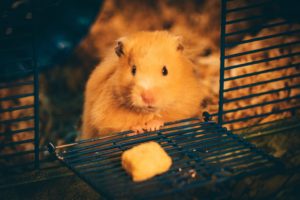
Both gerbils and hamsters are easy to look after which is why they are popular pets. There are 5 different species of hamsters that are commonly kept as pets, including Syrian hamsters and Dwarf hamsters. There are multiple species of gerbils as well, but the one most commonly kept as a pet is the Mongolian gerbil. Both of these critters are friendly, active, and love to dig and create burrows/tunnels. Some even enjoy playing with toys. It doesn’t matter which species you share your home with as they all require the same level of care in order to be safe in your home.
Have a secure cage

Your hamster’s cage is one of the most important purchases you’ll make as he or she will spend the majority of its time in it. The bigger the cage the better as hamsters need lots of stimulation. Make sure it’s a secure cage as hamsters are nifty escape artists. If you see your hamster biting the cage, you need to rethink its home set-up as it’s probably bored. Providing a hamster wheel, lots of bedding, and a variety of chew toys should keep your hamster engaged and stop it from biting the cage. If these things don’t solve the problem, consider whether your hamster could be seeking attention or feeling nervous in its home.
Additionally, you should also have a travel cage for your pet in the event you move or need to take him or her to a veterinary check-up. When travelling, always cushion the crate as told in the gerbil care guide, and secure it well to prevent it from being tossed during an impact or sudden stop.
A quiet home
Hamsters can make a fair amount of noise when they’re running on their wheel, but believe it or not, they don’t like living in a loud and busy environment. Noise can make hamsters stressed, so it’s best to place them in a quiet part of your home. This should be a place where they won’t be disturbed by lots of people, children shouting, or dogs barking. Your hamster’s cage should also be kept away from the television and radio.

Regularly clean out your hamster’s cage
You should be prepared to clean out your hamster’s cage on a weekly basis. You may also want to spot clean the cage on a daily basis to remove poop so that it’s nicer for your hamster to live in. Hamsters don’t like change and this includes having a clean cage. Make things as easy as possible for your pet by keeping around 50% of its old bedding and adding it to the new bedding that you put in. After you’ve cleaned the cage out with a hamster-friendly disinfectant, set the cage up exactly as it was. Hamsters are creatures of habit and won’t be impressed if you move their food bowl or favorite toy to a new corner.
Change food and water daily
If you leave water in your hamster’s bottle for several days, algae will start to grow. A hamster that consumes algae could get very sick and experience:
- Vomiting
- Diarrhea
- Respiratory problems
- Convulsions
Keep your hamster safe, by changing their water every day. Food should also be replaced daily. Perishable food, such as fruit and vegetables will start to decay after 24 hours, and this will stop your hamster from getting essential nutrients.
Supervise children
Hamsters are small and typically weigh between 0.7 oz. and 6 oz. If you have children, make sure you supervise them at all times when handling or playing with your hamster. Young children shouldn’t handle a hamster as they may hold it awkwardly or too tightly and the hamster may bite the child in protest. For this reason, keep your hamster in a room that’s not accessible to a child or in a cage located out of their reach. You may even want to opt for a glass or plastic cage with solid sides so your child isn’t tempted to poke their finger through and agitate your hamster.
Safe bedding
A hamster will sleep for up to 14 hours per day, so good bedding is essential. You can’t just give your hamster any old thing to use as bedding, though. Pine and cedar shavings are particularly dangerous to hamsters, so avoid these. Other dangerous bedding materials include:
- Sawdust
- Cotton bed fluff
- Scented bedding
- Shredded newspaper
- Cat litter
Safe bedding options for hamsters include Aspen wood shavings, toilet paper, soft hay, and ink-free shredded paper. Hamsters love to dig, bury, play, and move around their bedding, and they really can’t have too much of it. Studies have even found that having 40 cm or more of bedding can improve the health and well-being of Syrian hamsters. Give your hamster as much fun as possible by giving them a variety of safe bedding so they can find their favorite.
Hamsters aren’t too time-consuming and they’re easy animals to care for. But you still need to take some measures to give your hamster the best life possible and this includes setting a short time aside each day to maintain its home.
If you’d like to learn more about caring for Hamsters, check out “Basic First Aid for Rabbits & Pocket Pets.”










